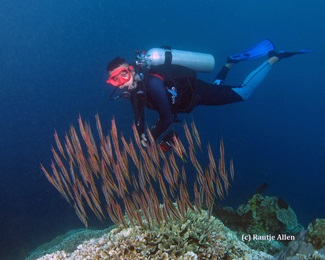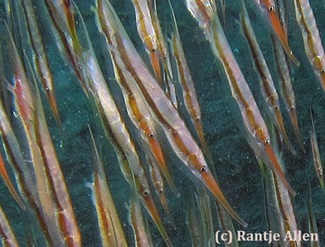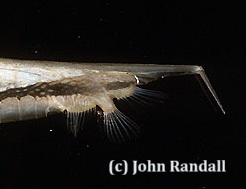Loading content - please wait...
Razorfish keep their noses down
Razorfish and shrimpfish swim in synchronized groups. Typically, they keep their noses down. They are a graceful sight for divers to enjoy.
Distinctive behavior & appearance
These fishes look like flattened razors. Their bodies are light in color with a dark body line. This line reaches from their long noses all the way to the back. Also, the line passes over the eye.
Most distinctive is their swimming pattern. Divers can see them in occasional pairs. Most often, however, they will gather in large schools, forming a shimmering curtain. Usually, they keep a cautious distance from scuba divers. When they decide to move, all the fish in a school will point their noses in the same direction and swim quickly away. Then, they will settle back to their head-down position.
Found through the Indo-Pacific and Indian oceans, they typically live at depth between two and fifteen meters. They tend to prefer areas with some potential for silting. They eat mysid shrimps.
The Razorfish common in Gorontalo
Centriscidae is a small family of fishes that tend to swim with their heads pointed downwards. They all look practically the same. There are two genera: Aeoliscus and Centriscus.
Centriscus scutatus is the species common in Gorontalo. Its common name is Grooved razorfish. This is because the fish has an interorbital groove. That is a narrow depression that runs between its eyes and along the skull. Only scientists in a laboratory can observe this.
Most helpful is for divers to observe the fish’s tail. Actually, what looks like the tip of the tail is the fish’s first dorsal spine. It lies flat along the top of the body and projects beyond the actual tip of its tail. To divers, the fish appears to have a long, thin, and rigid tail.
Confusing similarities
The fish most likely to be confused with the Grooved razorfish is Aeoliscus strigatus. Divers usually call this the Coral shrimpfish. Other common names include Jointed razorfish, Striped shrimp fish, and variations of those words. Careful observers look for the only visible distinctive of this species. This fish has a hinge on the end of its dorsal spine, which swings to the side as the fish moves. It functions like a rudder.
The largest of the shrimpfishes is Centriscus cristatus. It lacks the hinge and its stripe is yellowish with several perpendicular dashes above the stripe. We have not observed this fish in Gorontalo.
The fourth shrimpfish is Aeoliscus puntulatus. In addition to the hinged tail, it sports fine black spots above and around the mid-lateral stripe. We have not observed this species in Gorontalo.
The popular generic name shrimpfish comes from all the bony plates that compose the bodies of these razor-shaped fishes.
For your chance to see these beautiful fish in Gorontalo, make your dive reservations directly with Miguel’s Diving.









Sorry, comments are closed for this post.